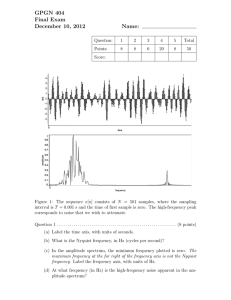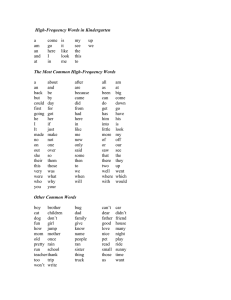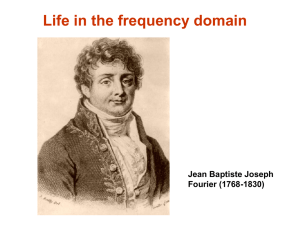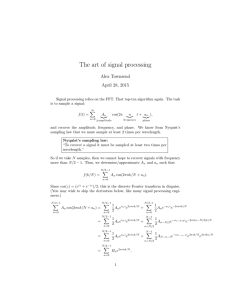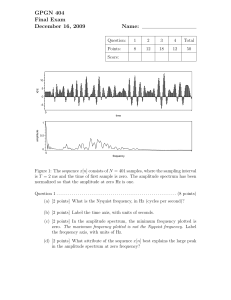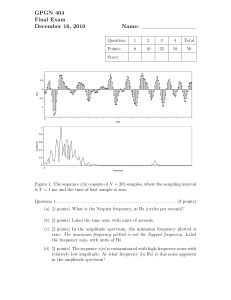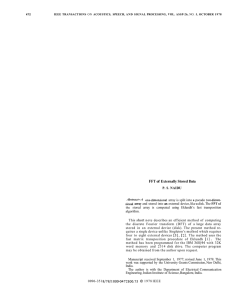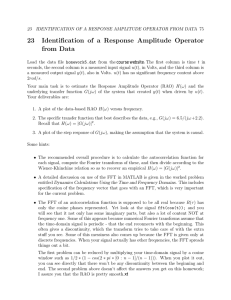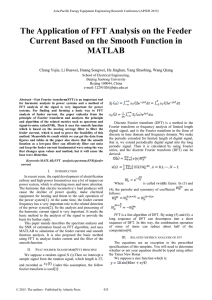GPGN 404 Final Exam December 13, 2011 Name:
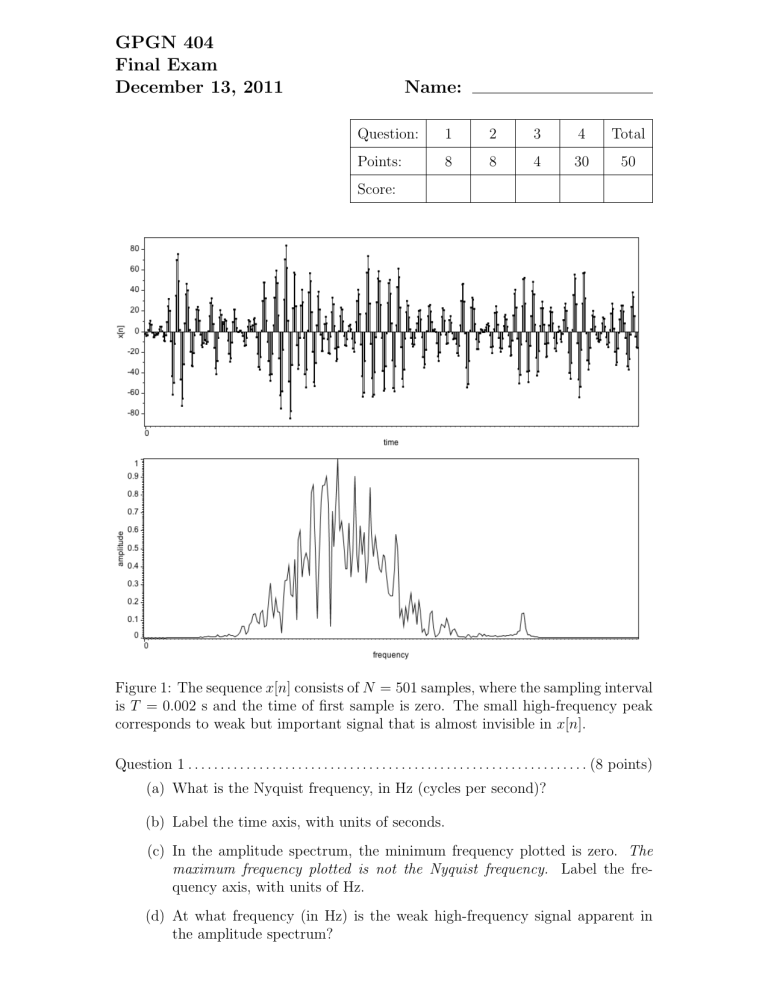
GPGN 404
Final Exam
December 13, 2011 Name:
Question: 1
Points:
Score:
8
2
8
3
4
4 Total
30 50
Figure 1: The sequence x [ n ] consists of N = 501 samples, where the sampling interval is T = 0 .
002 s and the time of first sample is zero. The small high-frequency peak corresponds to weak but important signal that is almost invisible in x [ n ].
Question 1 . . . . . . . . . . . . . . . . . . . . . . . . . . . . . . . . . . . . . . . . . . . . . . . . . . . . . . . . . . . . . . (8 points)
(a) What is the Nyquist frequency, in Hz (cycles per second)?
(b) Label the time axis, with units of seconds.
(c) In the amplitude spectrum, the minimum frequency plotted is zero.
The maximum frequency plotted is not the Nyquist frequency.
Label the frequency axis, with units of Hz.
(d) At what frequency (in Hz) is the weak high-frequency signal apparent in the amplitude spectrum?
Question 2 . . . . . . . . . . . . . . . . . . . . . . . . . . . . . . . . . . . . . . . . . . . . . . . . . . . . . . . . . . . . . . (8 points)
Consider the sequence x [ n ] in Figure 1. Describe in words and equations (not a computer program) how you would use a fast Fourier transform (FFT) to implement a system that highlights the high-frequency signal, by attenuating other frequencies. Be specific enough that a computer programmer could implement your system in any programming language. Specifically, ...
(a) How would you choose the length for the FFT?
(b) How would you construct from x [ n ] an array of values to be transformed?
(c) Assume that you have performed the FFT to obtain X [ k ], where k is the frequency sampling index. How would you obtain the array Y [ k ] from X [ k ]?
(d) Finally, how would you obtain the output sequence y [ n ]?
Question 3 . . . . . . . . . . . . . . . . . . . . . . . . . . . . . . . . . . . . . . . . . . . . . . . . . . . . . . . . . . . . . . (4 points)
Suppose that you are given a notch filter that can zero amplitude at any specified frequency.
(a) Describe how you might use this notch filter differently, to preserve the high-frequency signal in Figure 1, while attenuating all other frequencies.
(b) How might this system be better or worse than the one based on FFTs?
Page 2 of 4
Question 4 . . . . . . . . . . . . . . . . . . . . . . . . . . . . . . . . . . . . . . . . . . . . . . . . . . . . . . . . . . . . . (30 points)
Consider a linear time-invariant system with response H ( z ) =
1
2 z + 1 +
1
2 z
− 1
.
(a) Sketch the impulse response for this system.
(b) Is this system causal? Is it stable? For both questions, explain your answers.
(c) What is the frequency response H ( ω ) for this system?
(d) Sketch the amplitude and phase responses A ( ω ) and φ ( ω ) for this system for − π < ω < π . Label axes carefully.
(e) Where are the poles and zeros for this system?
(f) What is the region of convergence for the system response H ( z )?
(g) In plain simple English (not equations), what does this system do?
Page 3 of 4
(h) Write a computer program fragment that for this system computes an output array of N t n = 0 , 1 , 2 , . . . , N t samples y [ n ] from an input array of N t
− 1.
samples x [ n ], for
(i) If input x [ n ] = 7 (is constant), what is the output y [ n ]?
(j) For input x [ n ] = cos( πn/ 2), what is the output y [ n ]?
(k) Let X ( ω ) and Y ( ω ) denote discrete-time Fourier transforms (DTFTs) of arbitrary input and output sequences x [ n ] and y [ n ]. For this system, write
Y ( ω ) in terms of X ( ω ).
(l) Let X [ k ]) and Y [ k ] denote discrete Fourier transforms (DFTs) of arbitrary input and output sequences x [ n ] and y [ n ]. Assume that the input sequence x [ n ] has length N , before transforming. For this system, write Y [ k ] in terms of X [ k ].
(m) If the time sampling interval T = 0 .
2 s, what frequency (in Hz) is most attenuated by this system?
Page 4 of 4
